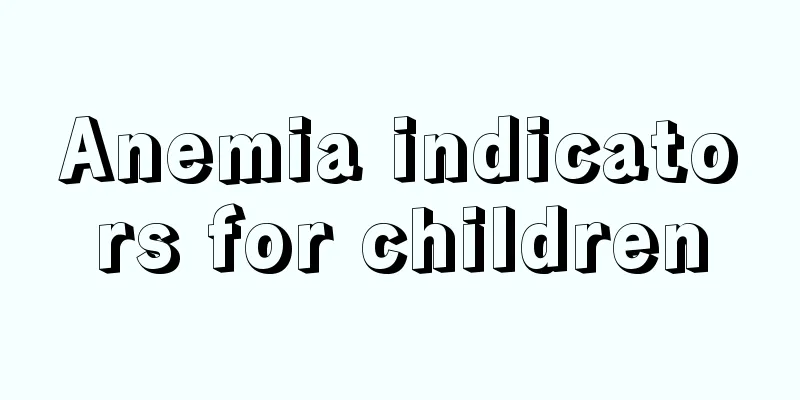Anemia indicators for children

|
Anemia has a relatively large impact on people's health. Generally, anemia can cause people to feel listless, have loss of appetite, and have a pale complexion. If a child is anemic, it will affect the normal development of the child's body and make the child's physical development slow down. Ischemia in children can lead to a decrease in the number of red blood cells in the body, which is very harmful to children. So, what are the indicators of anemia in children? 1. What does it mean when children have low anemia indicators? According to the amount of hemoglobin and the number of red blood cells in the peripheral blood, children's anemia can be divided into four degrees: mild, moderate, severe and extremely severe. The indicator of anemia in children is mild, which means the red blood cell count is between 3-4×1012/L. The hemoglobin level standards vary for each age group. For example, a newborn's hemoglobin level is 145-120 (g/L) which is a mild indicator, a child under 6 years old has a hemoglobin level of 110-90 (g/L) which is a mild indicator, and a child over six years old has a hemoglobin level of 120-90 (g/L) which is a mild indicator. 2. Common causes of anemia in children Nutritional iron deficiency anemia is the most common type of anemia in children. The main clinical feature is microcytic hypochromic anemia, which is common in children aged 6 months to 2 years. Hemolytic anemia refers to a type of anemia caused by shortened red blood cell lifespan, increased destruction, and enhanced bone marrow hematopoiesis that is insufficient to compensate for the loss of red blood cells. It is characterized by anemia, jaundice, hepatosplenomegaly, high reticulocytosis, and hyperplasia of bone marrow erythroblasts. 3. Prevention of anemia in children The main thing is to do a good job in health education. Parents should realize the harmfulness of this disease to children and the importance of prevention. Specific measures should include health guidance for pregnant mothers, proper feeding of children after birth, emphasis on timely addition of complementary foods rich in iron, especially animal foods such as various red meats, liver, etc., treatment of digestive system diseases, malnutrition and infectious diseases, early administration of iron supplements for premature infants and twins, and attention to the supply of nutrients for children in the recovery period of the disease. |
<<: What's wrong with the child's poop?
>>: Will children's vulvar leukoplakia heal on its own?
Recommend
Can children eat pumpkin?
Pumpkin is a very common food in our lives, and t...
White spots on the child's face
Children are the group of people that families an...
What is the disease that causes yellow eyes in children?
For many new mothers, they don’t know much about ...
What is the height and weight of a six-year-old child?
We all know that the standards of children's ...
What time is best for children to go to bed at night?
Nowadays, many young parents are prone to late sl...
What should I do if my child’s face turns red due to allergies?
Children's faces are often allergic. At this ...
How many times a day is normal for a newborn baby to poop?
For many newborns, if they want to grow up health...
Can a child's strabismus heal itself?
If a child has strabismus, it is very serious and...
What are the dangers of anemia in infants and young children?
In life, the probability of babies suffering from...
How should constipation in children be treated?
Constipation is a very common phenomenon. With th...
What should we do if children are infected with Helicobacter pylori?
Helicobacter pylori infection in children is a di...
What should I do if my child has poor resistance?
Everyone must know what resistance is. Resistance...
Symptoms and treatment of sinusitis in children
The group most susceptible to sinusitis is childr...
Is there any cure for a child's brain tumor? Authoritative experts are here to answer!
If you find that your child has a brain tumor, pa...
Symptoms of autism in six-month-old babies
Autism is a disease with a high incidence rate in...









